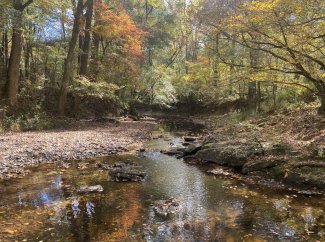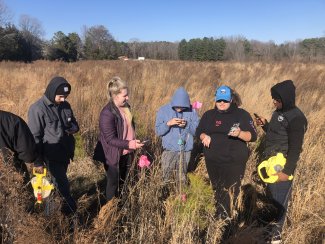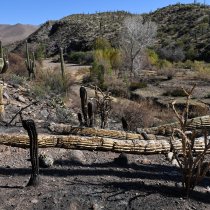Out of the Classroom and Into the Field with Carolina Wildlands
May 28, 2024
In the U.S. Carolinas, where the Piedmont Plateau meets the Coastal Plain, rolling hills and deciduous forests give way to the longleaf pine forests of the Sandhills. This area provides ample opportunity to explore diverse regional habitats and investigate changing ecosystems. Thanks to an internship program supported by the Carolina Wildlands Foundation, students from local colleges and universities have the opportunity to gain fieldwork experience using protocols adapted from the NEON Program.
A Foundation for Conservation and Education
The Carolina Wildlands Foundation was established in 2021 by Brad Turley and Pati Martin to support regional conservation efforts and provide educational opportunities for local undergraduates who would otherwise have limited chances to experience ecological fieldwork. Its cornerstone is the Southern 8ths Biological Field Station, a 1600-acre conservation area located about 40 miles southeast of Charlotte, NC and spanning the border of North and South Carolina.

Thompson Creek in autumn. Photo credit: Carolina Wildlands Foundation.
Turley originally came to the area for horses but quickly fell in love with the unique landscape. “I was awestruck by how cool this place is,” he says. “We are right at the end of the Piedmont, where it turns into sand. The flora and fauna are completely different on either side of the divide. Here, we have rock and clay with lots of hickory and oaks. Just a mile away, it’s sandy soil and longleaf and wire grass.” Working with local naturalists and conservation experts starting in 2015, Turley began managing the land for conservation, which included reestablishing some native prairie areas. The conservation area grew from an original 77 acres to its current 1600 over several years.
The Carolina Wildlands Foundation—led by Turley and Martin along with directors David Harper and Dwight Dimaculangan—now manages the land and educational programs at the Southern 8ths station. In addition to land conservation, the foundation is committed to expanding educational opportunities in ecology. To that end, they have established internship and fellowship programs with local universities including Wingate University, Winthrop University, Francis Marion University, and Newberry College. These programs include:
- A 10-week paid internship program for undergraduates providing field experience in ecology under the direct supervision of Carolina Wildlands staff.
- A field biology research grant for principal investigators and student co-investigators, providing the opportunity to conduct individual research projects at the Southern 8ths station.
Field Ecology in the Fall Line
The Southern 8ths station lies in a transitional area known as the Fall Line (or Fall Zone) where the hilly, elevated terrain of the Piedmont descends to the lower, flatter rolling Sandhills of the Coastal Plain. The geological boundary between these two major landforms has exceptionally high biodiversity, with plant and animal species that are often distinct in each adjoining ecosystem. The region has also been heavily impacted by human activity, especially agriculture dating back to before the U.S. Revolutionary period. The station features a diverse mix of upland and bottomland hardwood forest, planted and native pines, reclaimed native grasslands and prairies, and freshwater ponds, wetlands, and streams. Most of the land has been previously farmed for cotton and row crops and is in various stages of restoration.
The internship program supports four to six undergraduate students each semester who are exposed to several aspects of field ecology, including plant phenology, soil studies, organismal biodiversity, and water quality monitoring. Students learn how to make and record field observations, among other aspects of field ecology. They are also expected to share their observations through a journal published on the Carolina Wildlands website and a final presentation at the end of the course.

Students head into the field to do a box turtle study with the Carolina Wildlands Foundation. Photo credit: Carolina Wildlands Foundation.
Brianna Bergamini, the Prairie Keeper at Southern 8ths, co-leads the internship program and manages prairie restoration efforts for Carolina Wildlands. She says, “Learning from textbooks is so different from actually seeing things in nature. In textbooks, everything is perfect and easy to identify. In the field, things look different. They may be hidden by brush or may not look exactly as expected. That’s what’s so special about giving students opportunities for field work.”

Interns with the foundation setting transects in the field. Photo credit: Carolina Wildlands Foundation.
The primary field protocols now used by Carolina Wildlands are based on NEON’s protocols. Turley reached out to NEON in 2022 at the recommendation of Dwight Dimaculangan, department chair at Winthrop University. He and his team ultimately connected with Engagement staff at NEON, including Liz Knapp. Knapp – the recently-retired Senior Curriculum Developer for NEON – helped to identify and modify field protocols appropriate for Carolina Wildlands and their students. Ultimately, she sent several NEON protocols, including Plant Phenology, Surface Water Chemistry, Aquatic Macroinvertebrates, Stream Discharge, and Ground Beetle Sampling. (You can view NEON protocols in NEON’s Online Document Library.) The team at Carolina Wildlands further adapted and simplified the protocols to fit the needs of the program and its students, taking time, equipment, and existing resources at the foundation into consideration.
They initially started with the Plant Phenology protocol with the Spring of 2023 cohort. As part of the Plant Phenology protocol, students also participate in Nature’s Notebook, a citizen science project run by the U.S. National Phenology Network (a NEON partner). They have since implemented Benthic Macroinvertebrates with internship participants and plan to roll out additional protocols in the future. Students have been enthusiastic about the protocols and the field skills they are learning.

The field sampling protocols used by the foundation (like this fish study) are based on NEON protocols. Photo credit: Carolina Wildlands Foundation.
Turley says that the NEON protocols had a big influence on the design of the internship program and decisions around technology deployment, setup of research quadrats and transects, and other elements of field station design. While they do not have access to higher-end sensor instrumentation such as the NEON flux towers or Airborne Observation Platform (AOP), they have implemented “affordable tech”—including drones, audio recorders, endoscopes, multiple camera types, and thermometers—to supplement observational programs.
Laura Tedeschi, who manages marketing for Carolina Wildlands, says, “The NEON protocols really inspired us as we set up the internships and gave us a framework for how to teach these interns and train them in the field. We were able to build a curriculum around the materials NEON sent us. It’s just been phenomenal.”
Field Experiences that Transform Lives
The internship and fellowship programs offered by Carolina Wildlands are opening up new possibilities for students who might otherwise not have exposure to field ecology. Some of their interns have gone on to join the staff at Southern 8ths or pursue ecology careers elsewhere. More than half of the participants said they changed their major after completing the program.
Morgan Warner, now the Fauna Keeper for Carolina Wildlands, had originally intended to go to medical school. She participated in a fellowship program at Southern 8ths. “This was my very first research experience,” she says. “I realized in my sophomore year that I didn’t want to continue with pre-med. After taking an ecology class and getting the field experience here, I knew I wanted to be outdoors and do this for the rest of my life.”
Students learn kick net sampling. Photo credit: Carolina Wildlands Foundation.
In setting up the internship program, Turley focused on smaller, local teaching colleges with diverse student populations. Many of the students in their programs are the first in their families to attend college. Most have had no other opportunities to conduct field research or participate in hands-on science. It was important to Turley to have a paid internship program that would make participation more accessible for students who may not have a lot of financial support. He says the program has been successful in attracting diverse participants over the years, including many underrepresented groups in STEM.
Currently, ecology is viewed as a field that is not very diverse. Field work is often done in remote locations difficult to access, and careers can sometimes be lower-pay jobs, especially for early career researchers. These factors can be barriers to growing diversity in the science. Part of the NEON mission is to build up the next generation of scientists and ecologists; having NEON protocols used by Carolina Wildlands to give students a hands-on ecology experience is a door-opening opportunity.
Over the last two years, 47 students have completed internships or fellowships through Carolina Wildlands. The team hopes to implement more NEON protocols in the future and also expand partnerships with other biological stations, conservation organizations, and local landowners. Turley would like to see a conservation corridor set up between Southern 8ths and the Carolina Sandhills National Wildlife Refuge to the south and the Uwarrie National Forest to the north. “If you come here, in the rugged hills and valleys of the Piedmont, you’ll see it’s a very special place that needs to be protected,” he says. “We are trying to expand beyond just the farm to the whole watershed. We are getting word out to other landowners that they have to preserve this.”


